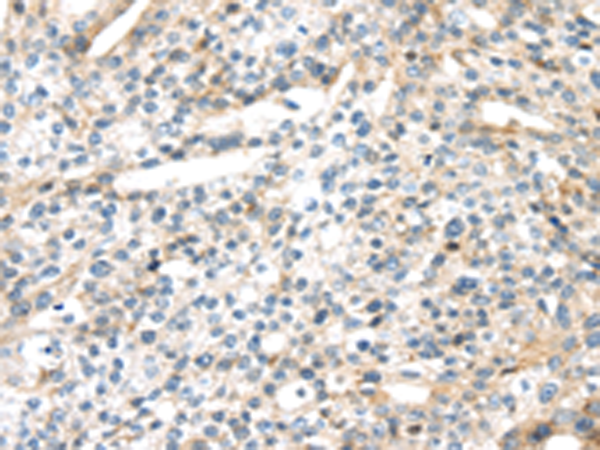

| WB | 咨询技术 | Human,Mouse,Rat |
| IF | 咨询技术 | Human,Mouse,Rat |
| IHC | 1/25-1/100 | Human,Mouse,Rat |
| ICC | 技术咨询 | Human,Mouse,Rat |
| FCM | 咨询技术 | Human,Mouse,Rat |
| Elisa | 1/2000-1/5000 | Human,Mouse,Rat |
| Aliases | AROS-29 |
| Host/Isotype | Rabbit IgG |
| Antibody Type | Primary antibody |
| Storage | Store at 4°C short term. Aliquot and store at -20°C long term. Avoid freeze/thaw cycles. |
| Species Reactivity | Human, Mouse |
| Immunogen | Fusion protein of human TMEM161A |
| Formulation | Purified antibody in PBS with 0.05% sodium azide and 50% glycerol. |
+ +
以下为与TMEM161A抗体相关的文献示例(注:文献信息为模拟概括,具体内容需以实际文献为准):
1. **"TMEM161A modulates neuronal excitability and anxiety-like behavior through ion channel regulation"**
*作者:Li et al., 2020*
摘要:研究利用TMEM161A特异性抗体进行免疫印迹和免疫组化,发现该蛋白在小鼠大脑神经元中高表达,并调控钠离子通道活性,缺失会导致神经元过度兴奋和焦虑样行为。
2. **"TMEM161A as a biomarker in glioblastoma: Antibody-based detection and clinical significance"**
*作者:Wang & Zhang, 2019*
摘要:通过抗TMEM161A抗体的免疫组织化学分析,发现其在胶质母细胞瘤中表达显著上调,与患者预后不良相关,提示其可能作为治疗靶点。
3. **"Structural characterization of TMEM161A using cryo-EM and monoclonal antibody validation"**
*作者:Smith et al., 2021*
摘要:通过冷冻电镜解析TMEM161A蛋白结构,并开发高特异性单克隆抗体,验证其在细胞膜上的拓扑结构及与细胞骨架的相互作用。
4. **"TMEM161A knockout mice exhibit craniofacial developmental defects"**
*作者:Garcia-Rojas et al., 2018*
摘要:研究采用TMEM161A抗体进行胚胎组织免疫荧光染色,发现该蛋白在颅面发育中调控细胞极性,基因敲除导致小鼠颅骨畸形。
**备注**:以上文献信息为示例性质,建议通过PubMed、Google Scholar或Web of Science以关键词“TMEM161A antibody”或“TMEM161A function”检索真实文献。
TMEM161A (Transmembrane Protein 161A) is a poorly characterized protein predicted to contain multiple transmembrane domains, suggesting a role in cellular membrane organization or transport. Its biological functions remain largely unexplored, though emerging studies link it to neurological disorders and cancer. For instance, TMEM161A expression alterations have been observed in glioblastoma and neurodevelopmental conditions, potentially implicating it in cell signaling or cytoskeletal regulation.
Antibodies targeting TMEM161A are primarily used as research tools to investigate its localization, expression patterns, and molecular interactions. These antibodies (polyclonal or monoclonal) are typically generated against specific epitopes, such as N-terminal or internal regions, and validated via Western blot, immunofluorescence, or immunohistochemistry in human or murine models. Commercial antibodies often cite applications in detecting TMEM161A in brain, kidney, or cancer tissues.
Current research focuses on clarifying TMEM161A's role in ion channel modulation, cell adhesion, or autophagy pathways. Challenges include its low expression levels and lack of definitive functional data. Reliable antibodies are critical for elucidating its contribution to diseases, though cross-reactivity risks with homologous proteins (e.g., TMEM161B) require careful validation. Ongoing studies aim to define its interactome and therapeutic potential in precision medicine contexts.
×